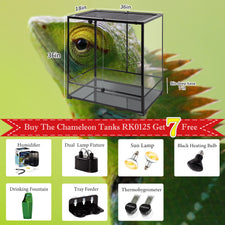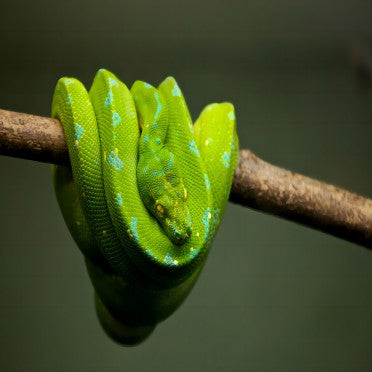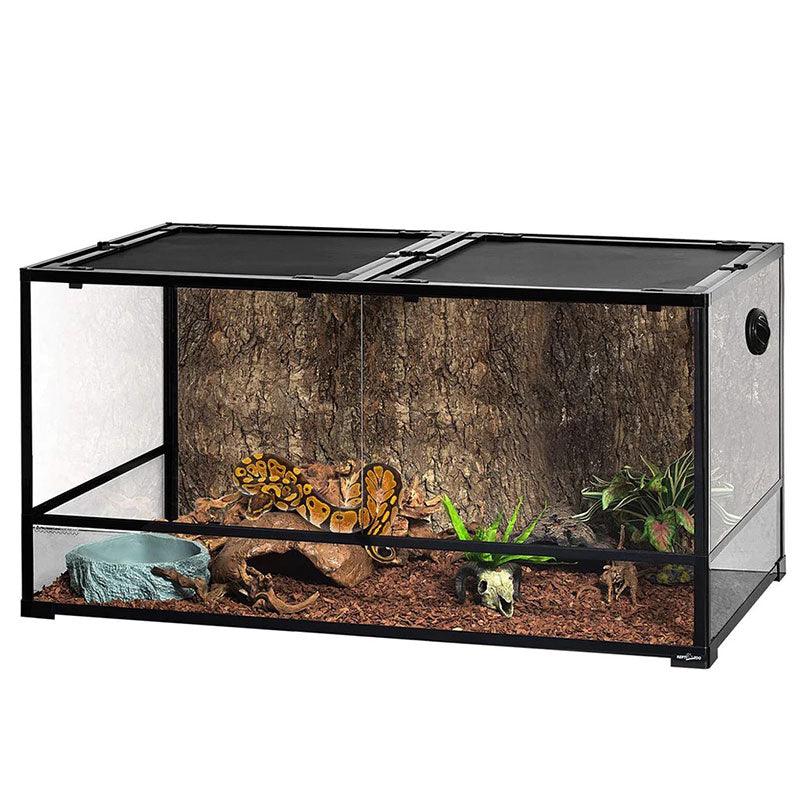Pets are a great way to experience companionship and a stress-free lifestyle while giving new meaning to our lives. However, you must take them seriously. They, too, have life and emotions and need love and care. That said, pets need not necessarily mean canines or felines.
Animals make great, human-friendly companions. Here, we are referring to one such adorable pet: the green tree python.
As natives of Australia and New Guinea, these reptile friends are usually residents of thick, tropical rainforests. If you are someone looking to adopt a green tree python as your pet, this page is just for you.
In this article, we delve into the characteristics and behaviors of these creatures, their habitat requirements, ways to keep the enclosure clean, their lighting, heating, and humidity requirements, common health issues found in green tree pythons, their diet and water requirements, and more.
Let’s get started.

Green Tree Python - Characteristics and Behaviors
They are non-venomous.
Unlike most snakes, the green tree python is non-venomous. However, they have more than 100 teeth and can give a really painful bite!
They are quite long.
Compared to most other snake species, the green tree pythons are much greater in length. Usually, they grow to 4-6 ft long.
They come in a variety of colors.
As babies, they are usually bright yellow, red, or brown but turn green in color as they become adults. When they shed, their eyes turn milky-blue, and body color starts getting dull with a white sheen.
They prefer to stay in hiding.
Green tree pythons often like to hide around shrubs or bushes where they feel secure. However, they may sometimes remain hidden in the same place, which could lead to illness, as they won’t be able to thermoregulate properly.
They are shy.
These reptiles are shy and feel threatened, which may provoke them to bite. However, over time, they can be made docile and receptive to regular handling.
They can lead a long, healthy life.
Green tree pythons can live into their teens or even mid-20s if properly cared for. Compared to other snake species like ball pythons and corn snakes, green tree pythons are fragile, but they can lead healthy lives if attended to well.
Green Tree Python - Care Sheet (Starters)
Python Enclosures
Your reptile friend, the green tree python, needs much free space to move around. In the case of any reptile creatures, enclosures must be sufficiently large. That said, being arboreal, these pythons require you to provide branches and climbers within the cage or enclosure for them to perch or move freely. This lets them grow healthy both physically and psychologically.
While the rule of thumb is that the enclosure must allow the reptile to stretch completely, it’s recommended that the enclosure be at least 0.9m in length, 0.6m in width, and 0.6m in height to begin with.
Larger enclosures are always welcome. You can create habitats resembling ball python enclosures and tanks. Additionally, your friend’s enclosure must be covered with bushes and shrubs, offering them enough space to hide and remain secure.
As with ball python enclosures and tanks, keeping substrates in the green tree python’s enclosure is equally important as it offers the reptile creature a good hideout and a nice surface. Use aspen shavings, but never pine chips. Alternatively, paper-based bedding that’s commercially available also helps.
Lighting Needs
A key characteristic green tree pythons exhibit is that they are diurnal or daytime enthusiasts when young. As they become adults, they turn nocturnal, which means they are active during the night. So, as a great parent, you must ensure that your pet receives not just daylight but a proper balance of lighting during the night as well.
For this, you can resort to UVB lighting, which offers multiple benefits. Besides regulating hormonal changes, UVB lighting provides the necessary Vitamin D3 to build your pet’s immune system, boost their daily activity, and maintain proper appetite levels. While UVB lighting is not a mandate for green tree pythons, it’s advisable to keep lights on for 12 hours during the daytime and turn them off at night.
Heating Requirements
The heating needs of green tree pythons must be appropriately met to ensure their sound health and proper growth. It’s important to create a basking area for your reptile friend, provided with a ceramic heat emitter or a radiating heat panel. The temperatures should be just right, neither too hot nor too cold. Ideally, the temperature in the basking spot must be around 86-88 degrees Fahrenheit.
The best temperature range for the cooler side is 78-80 degrees Fahrenheit. For the nighttime, ensure the temperature lies between 70-75 degrees Fahrenheit but doesn’t fall below 70F.
Humidity
Humidity is as important as the right temperature for a green tree python. Make sure the enclosure offers sufficient humidity of 40-70%, as that helps prevent skin and respiratory issues in your pet. Use a hygrometer to check the humidity levels regularly.
Steps to Clean the Habitat or Enclosure
The procedure followed is similar to that used for cleaning the ball python enclosures and tanks.
Clean your pet’s enclosure by removing any droppings. Always tidy the habitat thoroughly at least once a week and disinfect it. Check out the steps mentioned:
- Place the green tree python in a safe and secure habitat.
- Remove all the decor and other substrates from the enclosure.
- Clean the tank with a disinfectant like a bleach solution.
- Rinse the enclosure with clean water and remove all the smell and traces of the disinfectant.
- Keep the habitat dry and all other furnishings.
- Put a fresh substrate and other decor back into the habitat.
- Finally, put the green tree python back into its enclosure.
Green Tree Python - Diet and Water Requirements
While proper habitat, the right temperature, adequate heating, and lighting are all critical, the most vital component in ensuring your pet’s health is the proper diet.
Check out some points regarding the diet needs of your reptile pet.
- Feed them on frozen-thawed rodents for a week.
- Adults can be fed with one small rat once every 10-12 days.
- Most green tree pythons eat a lot if allowed, but don’t let them turn fat and lethargic.
- They also eat frogs, birds, lizards, and others found on trees.
- They like warm prey. Make sure you feed only those thawed in hot water.
- Water is essential for their healthy growth. In the enclosure, add a bowl specially designed for snakes and fill it with fresh, cool water.
Do’s and Don'ts to ensure a balanced and healthy diet for your reptile pal.
- Feed smaller ones once a week and the adults every one or two weeks
- Always feed in an empty tank that’s away from the enclosure.
- Never feed them at times when they shed.
- Never provide live rodents as food; they may cause injuries to your pet.
- If you ever have to feed live rodents, never leave them unattended with your pet in the enclosure.
- Most importantly, frozen rodents and human food should never be prepared in the same area.
Common Health Problems Found in Green Tree Pythons
How do you know your reptile friend is hale and hearty? Just check the below signals.
- Stays active
- Has clear eyes except when shedding
- Eats well and passes stools regularly
- Skin is clear and free from lesions, scabs, or parasites
- Shedding is regular and as a single long piece
- Nose, eyes, and mouth are clear, with no discharge
Health Issues with Symptoms and Treatment/Precautionary Measures
Disease: Respiratory Tract Illness
Symptoms: Mucus in mouth and eyes; open-mouthed breathing
Causes: Lack of right temperature/humidity in the enclosure; infected by viruses, fungi, or bacteria
Treatment/Precaution: Ensure perfect temperature and humidity; consult a vet.
Disease: Ticks and Mites
Symptoms: Itching, Hyperactivity, Inflammation
Causes: Parasites on the skin
Treatment/Precaution: Clean and disinfect the enclosure, and talk to a vet.
Disease: Dermatitis
Symptoms: Blisters on skin; quick shedding
Causes: Unclean enclosure; skin infections by bacteria, viruses
Treatment/Precaution: Ensure appropriate temperature and humidity. Consult your vet.
Points to Keep in Mind when Taking Care of Green Tree Python
- These creatures regularly shed their skin and cover their eyes with eye caps.
- Ensure you maintain the appropriate humidity in the enclosure, as it’s important for shedding.
- Ensure that the shedding takes place as a single long piece of skin.
- Never take off the retained eye caps by yourself; it’s best to consult a vet if there are retained eye caps.
Wrapping Up
Green tree python makes a fantastic pet. With their ability to train to socialize, they can offer you the best friendly support by being a true companion.
Follow the guidelines on enclosures, heating, lighting, and humidity needs, diet and water requirements, and most importantly, the health issues, symptoms, and treatment options outlined in the article. This will help you nurture your reptile pal most effectively, letting it gel with you comfortably.
Just ensure you give your pet some time to get accustomed to it.
Happy parenting!










